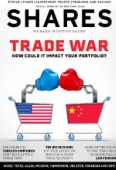Archived article
Please note that tax, investment, pension and ISA rules can change and the information and any views contained in this article may now be inaccurate.
The case for and against Japan

Japan’s Nikkei 225 index has quietly been one of the best performing major markets in recent years. It is the second-best performer out of eight available major equity market options (in sterling, total-return terms) since Shinzō Abe became prime minister for a second time in December 2012 and immediately launched his ‘Three Arrows’ programme.

The combination of fiscal stimulus, accommodative monetary policy (with the help of the Bank of Japan) and social and corporate reform does look to have boosted equity returns from the Tokyo market. The question that investors must address now is whether this can continue or not?
THE CASE AGAINST JAPAN
The ‘Three Arrows’ may be hitting the target, but sceptics will argue Japan is still far from a sound asset allocation option, even nearly 29 years after the bursting of a debt-fuelled equity and property market bubble that peaked in 1989.
1. Debt. Hampered by poor demographics, in the form of an ageing population, and the legacy of previous, failed attempts to spend its way out of trouble and into growth, Japan is saddled with huge debts. Government debt is 232% of GDP according to the Bank of Japan (BoJ).
That is the highest figure in the world and one that leaves the Abe administration with less ammunition than it would like. An increase in consumption tax from 8% to 10% is planned for October 2019, to raise some cash, but this has already been delayed for three years and with good reason, since 2014’s increase from 5% to 8% pushed the country into recession.
2. Growth and inflation. Both remain tepid. The economy shrank quarter-on-quarter in Q1 of this year, the first decline in nine quarters. Although some have blamed a harsh winter for that dip, the weather cannot be blamed for the Bank of Japan’s clear failure to drive inflation toward its 2% target. Governor Kuroda has even stopped giving a timescale for its inflation goal to be reached in what could be a tacit admission of failure.
In addition, corporate confidence, as measured by the Tankan survey, has begun to dip again. This matters as the Nikkei 225 stock index does seem to draw inspiration from the quarterly Tankan.
3. Politics. Financial markets still seem to be in thrall to Prime Minister Abe, but Japanese voters seem less enamoured. A series of scandals have seen the Cabinet’s approval rating drop to the lowest level since the Abe administration began in 2012, according to data from Japan Macro Advisers.
Abe won a third straight general election in December 2017 and he seems primed for a run toward the 2021 ballot, but nothing can be taken for granted given the generally short lifespan afforded to leaders of the Liberal Democratic Party. Were Abe to unexpectedly fall from office markets could take fright, at least temporarily.
THE CASE FOR JAPAN
• The Bank of Japan. The Bank of Japan is holding interest rates at -0.1% and showing no sign of either raising them or backing away from its ¥80tr a year qualitative and quantitative easing programme, which is it using to buy government bonds, to force down their yield, and purchase exchange-traded funds (ETFs) that track Japanese stocks. Low returns on cash and bonds could force investors toward equities, as has happened in the UK, US and Europe, especially as they might get to ride a tidal wave of BoJ cash there, too.
• Corporate reform. Encouraged by the creation of the JPX-Nikkei 400 index, which includes firms on the base of profits and governance not size, Japanese corporates are raising their game. Dividends and share buybacks are on the up while research from Japan Macro Advisers shows that return on equity (ROE) amongst Japanese corporates is rising as profit margins expand. ROE now exceeds the 8% goal laid out by a 2014 Government paper.
• Valuation. Japan’s stock market is not trading at or very near to its all-time highs, unlike say the UK or US. In fact, at around the 22,800 mark the Nikkei 225 index trades more than 40% below the peak it reached in December 1989.
As a result, Japan looks relatively cheap compared to other major markets, on an earnings basis, especially as profits are nowhere near past peaks, in contrast to the US and UK. Japan looks cheaper still on 1.3 times book (or net asset) value, according to research from M&G, especially as a lot of the assets are simply cash.
TEST CASE
After more than two decades of interest rates below 1%, multiple fiscal stimulus programmes and over a dozen rounds of QE since the early 1990s, Japan is the model that no western central banker wishes to emulate. As such, the Abe and Kuroda regime remains a key test case, as the European Central Bank and Bank of England continue to run ultra-loose monetary policy and the US Federal Reserve continues to tighten at a very steady pace.
Russ Mould, investment director, AJ Bell
Important information:
These articles are provided by Shares magazine which is published by AJ Bell Media, a part of AJ Bell. Shares is not written by AJ Bell.
Shares is provided for your general information and use and is not a personal recommendation to invest. It is not intended to be relied upon by you in making or not making any investment decisions. The investments referred to in these articles will not be suitable for all investors. If in doubt please seek appropriate independent financial advice.
Investors acting on the information in these articles do so at their own risk and AJ Bell Media and its staff do not accept liability for losses suffered by investors as a result of their investment decisions.
Issue contents
Aequitas
Big News
- Sosandar is a rare retail success story in 2018 with soaring shares
- Asset valuation concerns cloud Hammerson as it seeks £1.9bn disposals
- Shareholders rally to block excessive pay packages
- Can Jack’s work its magic as Tesco’s new discount chain?
- Renewed speculation that GlaxoSmithKline could spin off consumer division

 magazine
magazine













